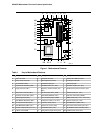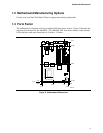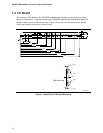
Motherboard Description
11
1.5 Microprocessor
The AP440FX motherboard operates with 2.1 V to 3.5 V Pentium Pro processors. An onboard
voltage regulator circuit provides the required voltages from the 5 V and 3.3 V taps off the power
supply. The onboard voltage regulator makes use of the VID capabilities to automatically adjust
its voltage output to match that of the installed processor. Pentium Pro processors running at 150,
166, 180, and 200 MHz are supported.
The Pentium Pro processor integrates the second level cache and cache controller that were
previously implemented on the motherboard. The internal, non-blocking L2 cache on the 150, 180
and 200 MHz processors is 256 KB, while second versions of the 166 and 200 MHz processors
integrate a 512 KB cache. The Pentium Pro processor has an advanced numeric coprocessor that
significantly increases the speed of floating point operations, while maintaining backward
compatibility with math coprocessors that comply with ANSI/IEEE standard 754-1985.
✏
NOTE
If you are installing a 3.5 V processor, a jumper must be installed on the jumper block located at
J8A2. See Section 1.13 for more information.
✏
NOTE
The 200 MHz Pentium Pro processor with 512 KB of cache memory is not supported on the
AP440FX motherboard.
1.5.1 Microprocessor Upgrade
Socket 8 is a 387-pin, modified staggered pin grid array (SPGA) zero insertion force (ZIF) socket,
along with a programmable voltage regulator for the microprocessor core. It provides users with a
performance upgrade path to OverDrive processors. The voltage regulator programming is
automatic and controlled by the VID pins of the processor.
1.5.2 Microprocessor Heatsink and Clips
An approved Pentium Pro processor heatsink is necessary for proper thermal dissipation in an LPX
compliant chassis. The processor/heatsink assembly must be securely fastened to the Socket 8 ZIF
socket by two clips. These clips fit over the heatsink assembly and attach to the outer wide tabs of
the Socket 8 assembly.
CAUTION
Do not use the older style of bail-wire clips for securing the heatsink assembly. These clips have
been found to damage the motherboard when installed or removed incorrectly.


















